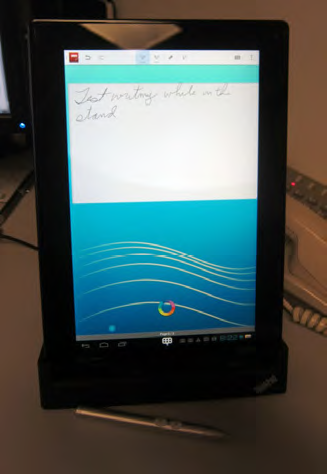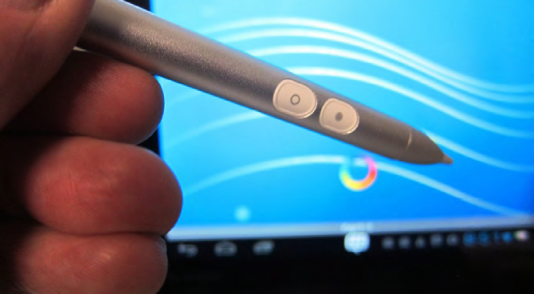Re-visiting N-trig tablet pens and the Lenovo ThinkPad Tablet
By Jon Peddie
Of all the tablets we’ve tested (and certainly not all that are in the market), one of my favorites is the Lenovo ThinkPad Tablet. One reason I like it is because it has excellent pen input capability. Introduced in late 2011 with a 2.1-GHz Tegra processor and Android 4.0.3 (Ice Cream Sandwich), the device has proven rugged, reliable, and useful.
However, the pen input has been challenging at times, and I thought it would be interesting to look into that a bit more. The catalyst for my enquiry was tablet pen maker N-trig. They visited us a few months back, and then I met with them in Israel and they told me about their new pen designs and software apps, and a firmware update, which got me intrigued.

The problems with trying to replicate the paper-and-pen writing experience with a glass surface-pen system are multifarious. One of the biggest problems is the parallax of the ink surface (the LCD screen) and the pen nib, which is a few mm away from the LCD due to the glass filter. It takes a little time to get your brain to accept the fact that the “ink” showing up on the screen is not coming directly (or immediately) from the nib of the pen. I think that’s the biggest barrier to general acceptance of pen-based computers.
The other problem is the shiny, slick screen surface itself—it’s reflective, which is distracting and sometimes impossible to overcome, and it’s very slick-slippery, which makes it too easy to slide off the word you are writing.
The net result of all those artifacts is that you learn to write slower and more deliberately—which raises the issue of productivity. My personal reason (desire) to use a pen-based tablet is to take notes and convert them into digital text for our reports. I’m not a good enough typist to type while a presenter is speaking, but I can keep up while writing—in cursive you can read; a dying skill, I fear.
So, armed with an updated tablet (new firmware) and a couple of new pen designs from N-trig (which required the firmware update), I set out to test and try it.
My first reactions were good, but not great. The new pen seems to be detected better: almost (about 95%) all of the strokes in my handwriting test were detected. I would get about 80% to 85% for the original pen.
The problem with the experience is that the surface of the screen is too slick (which makes pen detection more difficult) and the pens are too smooth. Since I need to hold the pen(s) hard against the surface, my finger keeps sliding toward the point and I have to adjust my hand. I haven’t found a way to have comfortable natural writing yet, but I’ll continue my investigation and learning curve.

You write in a writing app (which is a large icon of a notebook). The UI is intuitive, and even though I had the manual open on the screen in front of me, I barely looked at it.
The handwriting detection/character reading is amazing. I didn’t take any real care to write legibly; I have OK handwriting because, as mentioned, I still take notes in longhand and have to be able to read them later.
I also experimented with the equation app, and it too surprised me, and got my equation. The equation program that I have is a demo, not yet an app; nevertheless, it does quite well for me. It solves many equations but cannot recognize some complex equations. However, it will correctly recognize integral equations.
Response times
The response time of the system is a bit slow. You can almost measure the time it takes from when you touch the screen and start a stroke until the time the inking starts to appear—my rough estimate is it’s about 100 ms. I assume this is a function of the processor (and maybe memory) speed.
The one issue related to my review experience is the ability of the system to detect the first ink stroke. N-trig has improved this in its Gen 4 pen significantly, and is working on making the pen reporting 2x to 3x faster to eliminate lag-to-acquire time for the pen to synch to the system. This is an area N-trig says will be improved this year with the DuoSense Pen 2 firmware. The mechanics are now quite good, and they just need to refine the pressure curve and address a few other firmware tuning issues.
Naturally, the writing app takes time to convert from ink to characters. Nonetheless, it is easy to write in ink and later use the lasso to capture the ink and convert to text. This takes time so I often go between the two modes. The Vision Objects app also forces page changes vs. a continuous and endless “paper” as in OneNote from Microsoft.
The pen has programmable buttons. On Windows, they default to erase and right-click. The Google team on Android felt that developers should be able to decide whether they use buttons and assign functions to them.
This eliminates any standard being set but aligns with their intention of being “open.” If you open the Papyrus app on the desktop to the right of the main desktop page, you will find the first button is a lasso and the second is an erase function (your finger is also an erase function).
There are two tips with the new pen: the gray tip is softer and has more friction on the tablet. The black tip is more of a roller-ball feeling. N-trig has found that most men in North America prefer the higher friction. I do too.
The N-trig firmware does an excellent job of detecting and discriminating against your palm, so you can rest your hand on the tablet in a natural writing style—you can even set it up for left-handed writers. JPR’s Kathleen Maher is one such person—she was quite comfortable with the tablet, and the character recognition was able to deal with her slant and writing style (something others and I have difficulty with at times).
However, as you write and your hand slides down the screen, just as it would if you were writing on a paper tablet, your palm will come into contact with touch-screen controls at the bottom (main menu, back, multi-page) and activate one of them. This is beyond N-trig’s control and is part of the OS. Therefore, the range and size of the page on which you can write is limited.
The next set of tests we’re going to run is with the drawing app and with SketchUp. If I could get this to work satisfactorily, where I could get my hand-drawn block diagrams into Visio or PowerPoint, I would be a most happy camper.





